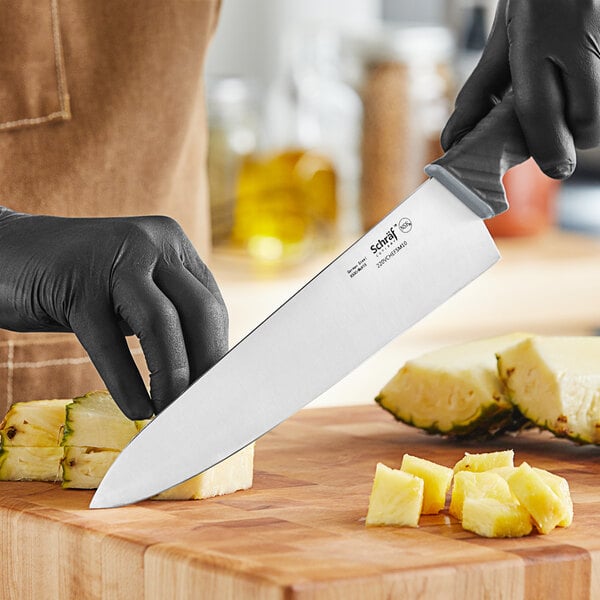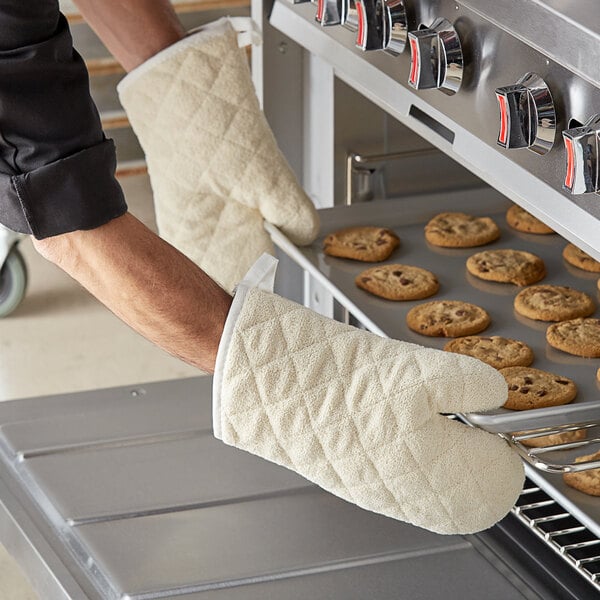
Kitchen accidents are common occurrences in commercial foodservice establishments, ranging from minor mishaps to serious injuries. These accidents can disrupt kitchen operations, impact employee morale, and even lead to financial losses for businesses. Understanding the most common kitchen accidents and implementing preventive measures is crucial for maintaining a safe working environment. By identifying potential hazards and emphasizing safety, foodservice professionals can reduce risks and create a more efficient and productive kitchen environment.
1. Cuts and Lacerations

Cuts and lacerations rank among the most common injuries in commercial kitchens, often resulting from the frequent use of sharp tools like knives, mandolins, and graters. These injuries can range from minor nicks to severe gashes that require medical attention, impacting the efficiency and safety of the kitchen environment. However, maintaining an orderly environment and establishing robust training reduces these risks in regular settings.
Common Causes of Cuts in the Kitchen
Many cuts in the kitchen are caused by improper knife safety and cutting techniques. Staff should always cut away from their bodies, use sharp knives and stable cutting boards, and return their tools to the proper place when finished. Additionally, sharp edges and broken dishware increase the risk of cuts and lacerations.
Some of the most common causes of cuts in the kitchen are:
- Cutting avocados or bagels into your hand
- Sharp edges on freshly opened cans
- Cleaning knives or leaving loose knives in the sink
- Unstable cutting boards slipping on a countertop
- Broken dishware and glassware
- Using dull knives for prep work
- Improper use of bladed equipment, such as grinders, slicers, or blenders
- Open blades sitting loose on workspaces or drawers
How to Prevent Cuts in the Kitchen
Proper training and organization go a long way toward preventing cuts in the kitchen. Specific strategies include:
- Keep your knives sharp and ready for use.
- Store knives safely in the proper place. Do not leave unused knives on countertops or loose in drawers without an edge guard.
- Train all staff on correct cutting techniques and safety procedures around bladed equipment.
- Anchor your cutting board to your counter with nonstick feet or a damp paper towel so it doesn't slip.
- Lie bagels flat on your workspace and cut them horizontally with your hand on top for stability. If bagels are a high-volume product, use a bagel slicer to increase safety and consistency.
- Offer cut-resistant gloves for prep work and encourage use.
2. Burns

Burns represent a significant hazard in the kitchen, often resulting from direct contact with hot surfaces, boiling liquids, or steam. If a staff member gets burnt, run the area under cool water and seek medical attention if blistering or blackened skin appears. Understanding how burns occur and implementing preventative measures are crucial for maintaining a safe kitchen environment.
Common Causes of Burns in the Kitchen
Most burns result from mishandling hot surfaces, utensils, and equipment. However, burns can also occur from steam, hot liquid spills, and spicy peppers. The following areas are most likely to cause burns:
- Touching stove burners, oven racks, grill grates, pot handles, or hot food
- Splashes from boiling water, oil, or other hot liquids
- Steam from opening oven doors, removing lids from boiling pots, or working with steamers
- Mishandling hot utensils, such as pots, pans, baking sheets, or metal serveware
- Touching spicy peppers or chile oil without gloves
How to Prevent Burns in the Kitchen
Wearing gloves is the best way to prevent burns in the kitchen. Other precautionary measures include:
- Wear heat-resistant gloves when working with hot equipment such as stovetops, ovens, grills, fryers, or pots and pans.
- Ensure oven mitts and protective gloves are dry before using them, as wet mitts transfer heat more quickly.
- Avoid placing hot pans or pots on unstable or inappropriate surfaces. Use pot holders to prevent heat transfer to metal workspaces.
- Carefully monitor pots and pans to prevent boiling over or splashing.
- When moving hot liquids, use containers with secure handles and pour slowly to avoid splashes.
- Open oven doors slowly and at a safe distance to allow steam to escape gradually.
- When lifting lids from boiling pots, tilt them away from your face and body.
- Regularly train kitchen staff on burn prevention techniques and first aid procedures for burns.
3. Spills

Spills are frequent in the kitchen, often leading to dangerous slip-and-fall injuries. Liquid, food, grease, and cleaning product spills create slippery floors if left unaddressed. Additionally, spills can cause cross-contamination and are a potential fire hazard. Implementing effective prevention measures against spills maintains a safe and efficient kitchen environment.
Types of Kitchen Spills
Spills in the kitchen occur in various ways and pose several hazards:
- Liquid spills: Water, sauces, and other liquids often spill during food preparation, cooking, or cleaning. These substances can create slippery surfaces that lead to falls and injuries.
- Food spills: Dropped food items, especially those with high moisture content, can contribute to a hazardous environment. These spills can cause cross-contamination or invite unwanted pests.
- Grease and oil spills: Frying and cooking with oil can result in greasy spills, which are exceptionally slippery and challenging to clean. These spills increase the risk of falls and pose fire hazards if left unattended.
- Chemical spills: Accidental spills of cleaning chemicals cause slippery floors and create harmful fumes. Mishandling these substances can lead to respiratory issues, skin irritation, or more severe health problems.
How to Prevent Spills in the Kitchen
Most spills can be prevented by using lids for containers holding liquids, and accidents resulting from spills are avoidable by addressing the mess promptly. Other safety measures include:
- Encourage a culture of cleanliness by having staff clean up spills immediately as they occur.
- Keeping workstations tidy minimizes the risk of accidents.
- Place non-slip mats in areas prone to spills, such as near sinks and preparation areas, to provide extra traction and reduce the likelihood of slipping.
- Store liquids and other spill-prone items securely and at appropriate heights, and seal containers tightly.
- Check that all kitchen areas are well-lit to increase the visibility of spills.
- Keep cleaning supplies readily available throughout the kitchen, including absorbent materials for liquid spills and appropriate cleaning agents for grease and oil.
- Regularly train kitchen staff on spill prevention and proper clean-up techniques. Emphasize the hazards associated with spills and the steps to take when they occur.
4. Trips and Falls

In a busy commercial kitchen, trips and falls can cause serious injuries and disrupt operations. Uneven surfaces, slippery floors, cluttered workspaces, and misplaced equipment are significant tripping hazards for your staff to recognize. Identifying the causes and implementing prevention measures enhances kitchen safety.
Common Causes of Falls in the Kitchen
As you inspect your kitchen, look for obstacles blocking walkways and high-traffic areas. Common causes of falls in the kitchen include:
- Items left on the floor, such as boxes, utensils, and food containers
- Wearing inappropriate or worn-out footwear can reduce traction and stability
- Uneven flooring, loose tiles, or wet surfaces due to spills or cleaning
- Inadequate lighting makes it difficult to see potential hazards
- Electrical cords and cables running across walkways
- Drawers and cabinet doors left open and obstructing walkways
How to Prevent Falls in the Kitchen
Keeping walkways and high-traffic areas clear is the best way to prevent falls in the kitchen. Other methods include:
- Use signage to indicate wet floors or uneven surfaces.
- Include non-slip, supportive shoes as part of your staff dress code requirements.
- Regularly clean and organize work areas to prevent objects from being left in walkways.
- Use cord covers or secure cables along walls and out of walkways.
- Close drawers and cabinet doors immediately after use.
- Clean up spills immediately and place wet floor signs in recently cleaned areas.
- Reduce the risk of collisions by implementing verbal alerts when entering or exiting the kitchen or high-traffic areas.
5. Fire

Fires are among the most dangerous accidents occurring in a kitchen, posing significant risks to people and property. Grease fires are particularly perilous, requiring specific procedures to extinguish. Ensure all staff are thoroughly trained on common fire causes, prevention, and emergency procedures should a fire occur.
Common Causes of Kitchen Fires
The most common cause of kitchen fires is leaving grease or oil on a hot surface unattended, leading to a fast-spreading flame that water can't extinguish. Use extreme caution when cooking with grease or oil to prevent fires from starting. Other causes of kitchen fires include:
- Leaving cooking equipment unattended, causing overheating
- Grease or food residue left uncleaned in the bottom of ovens or grills
- Malfunctioning or improperly maintained kitchen appliances, such as ovens, stoves, and fryers
- Storing flammable materials, such as paper towels, dishcloths, or packaging, too close to heat sources
- Sparks from overloaded circuits, damaged wiring, or faulty electrical appliances
Kitchen Fire Safety and Prevention
If a fire breaks out in the kitchen, never throw water on it. Electrical and grease fires will both grow with the addition of water, increasing the danger. Equip your kitchen with the right types of fire extinguishers and fire blankets, and all staff should know where they are and how to use them.
However, the best fire safety measure is preventing fires altogether. Here are a few ways to stop fires before they happen:
- Never leave cooking appliances unattended. Assign staff to continuously monitor equipment in use, especially when cooking with oils or high temperatures.
- Regularly clean cooking surfaces, ovens, and ventilation systems to prevent grease buildup, which can easily ignite. Ensure that all equipment is free from food particles and debris.
- Equip your kitchen with fire extinguishers, fire blankets, and smoke detectors.
- Store items like paper towels, dishcloths, and cleaning supplies in designated areas, and keep flammable items away from heat sources.
- Regularly inspect and maintain all kitchen appliances and electrical systems. Replace faulty equipment and repair any damaged wiring promptly to prevent electrical fires.
- Provide comprehensive fire safety training for all kitchen staff. Ensure everyone knows how to prevent fires, recognize hazards, and respond quickly in a fire emergency.
- Establish and enforce fire safety protocols, including proper equipment usage, immediate response to spills, and the importance of keeping a clean and organized kitchen.
6. Repetitive Motion

Repetitive motion injuries are a typical issue in the kitchen, resulting from continuous, repetitive tasks that strain muscles and joints. Chopping, stirring, lifting, reaching, and bending lead to long-term issues without the proper precautions. Understanding the types, causes, and prevention methods can help mitigate these injuries and promote a healthier work environment.
Types of Repetitive Motion Injuries
As the name implies, repetitive motion injuries are caused by the same movement repeated constantly. If left unchecked, it leads to several types of injuries over time, including:
- Carpal tunnel syndrome: This condition arises from repetitive hand movements, causing pain, numbness, and tingling in the hand and fingers.
- Tendinitis: Repetitive movements can inflame tendons, leading to tendinitis, which causes pain and swelling in the affected areas, such as the wrists, elbows, or shoulders.
- Tennis elbow: Also known as lateral epicondylitis, this injury results from repetitive arm and wrist motions, leading to pain and tenderness on the outer part of the elbow.
- Bursitis: This condition involves inflammation of the bursae, small fluid-filled sacs that cushion bones, tendons, and muscles. Repetitive movements can cause bursitis, leading to pain and discomfort in the shoulders and knees.
How to Prevent Repetitive Motion Injuries in the Kitchen
Preventing repetitive motion injuries involves adopting ergonomic practices and promoting a healthy work environment. Use the following tips to reduce repetitive motion injuries in the kitchen:
- Teach and encourage staff to use proper techniques when chopping, stirring, lifting, and carrying to minimize strain.
- Provide ergonomic kitchen tools and equipment, such as knives with comfortable handles, cutting boards at appropriate heights, and adjustable stools for tasks requiring prolonged standing.
- Implement a schedule that allows staff to take regular breaks to rest and stretch.
- Rotate staff through different tasks to prevent repetitive strain on specific muscle groups.
- Ensure that all workstations are well-organized and free of clutter. Easy access to frequently used items reduces the need for excessive reaching and bending.
How to Prevent Kitchen Accidents
Preventing accidents and injuries in the kitchen is essential for ensuring a safe and efficient work environment. Implementing straightforward safety measures can significantly reduce the risk of common kitchen hazards. Follow these tips for preventing accidents and injuries in the kitchen:
- Maintain cleanliness: Keep work areas clean and organized. Promptly clean up spills, remove clutter, and ensure floors are dry to prevent slips and falls.
- Use proper equipment: Invest in high-quality, well-maintained kitchen tools and equipment. Ensure that knives are sharp, and appliances are in good working condition to prevent mishaps.
- Wear appropriate attire: Encourage staff to wear non-slip shoes, protective gloves, and clothing that covers exposed skin. This can help prevent cuts, burns, and slips.
- Follow safe lifting practices: Teach staff to lift heavy objects properly by bending at the knees and keeping the back straight. Use carts or dollies to move heavy items when possible.
- Practice good knife safety: Use knives correctly, cutting away from the body and keeping fingers clear of the blade. Store knives securely in knife blocks or on magnetic strips.
- Implement fire safety measures: Install smoke detectors and keep fire extinguishers accessible. Train staff on how to use them and respond to kitchen fires.
- Ensure proper ventilation: Maintain adequate ventilation to prevent the buildup of smoke and fumes. Regularly clean hoods and ventilation systems.
- Promote hygiene: Encourage frequent handwashing with soap and warm water, especially before and after handling food. This reduces the risk of cross-contamination.
- Stock your first aid kit: Keep a first aid kit accessible and frequently restock supplies to prepare for injuries.
- Train staff regularly: Provide ongoing safety training to ensure all staff are aware of potential hazards and how to prevent them. Regularly review safety protocols and procedures.
- Monitor workloads: Avoid overworking staff, which can lead to fatigue and increase the risk of accidents. Ensure that breaks are taken regularly and workloads are manageable.
Understanding common kitchen accidents and implementing proper safety measures in a commercial kitchen is crucial to ensure the well-being of employees, prevent costly liabilities, and maintain a smooth workflow. By proactively identifying potential hazards, providing adequate training to staff members, and enforcing strict safety protocols, businesses can significantly reduce the risk of accidents occurring in the kitchen. Safety should always be a top priority in any commercial kitchen environment to promote a positive work culture and protect the business's overall success.





